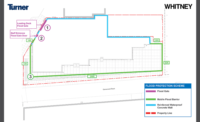CM Pioneer John Tishman Dies at 90
Construction management pioneer John Tishman died Feb. 6 at age 90 after a long illness. He managed the construction of the original 110-story World Trade Center twin towers in New York City and the 100-story John Hancock Center in Chicago, as well as Century City in Los Angeles, Walt Disney’s EPCOT Center in Florida and the restoration of Carnegie Hall.
John was the grandson of Julius Tishman, who founded Tishman Realty & Construction Co. Inc. in 1898. The company for many years built its own buildings exclusively. In the late 60s, John convinced the family there could be great opportunities in putting its experienced staff to work managing projects for clients for a negotiated fee. It paid off: “Every time we had a challenging project, it raised the caliber of our project staff,” Tishman said in an ENR cover profile of the company (ENR 10/19/1989 p. 44).
It was also good business. The firm went through many corporate evolutions, growing to $1 billion in annual revenue when it was acquired by AECOM in 2010 (ENR 8/2/10 p. 10). Daniel R. Tishman, John’s son, said he decided to sell the well-known company to give it deeper financial resources and global reach. He became a member of the board of AECOM.
Charles DeBenedittis, a 25-year veteran of Tishman Realty and retired partner at developer Tishman Speyer, remembers John Tishman as “an innovator. His innovative thinking and ability to promote new things was really unusual.” He created the Tishman Research Corp. to develop new products, materials and methods. Manufacturers such as Johns Manville, U.S. Gypsum, Otis and others “shared ideas that were not yet in the market, and we tried new products and materials in our projects,” says DeBenedittis. At the original World Trade Center, for example, the firm helped develop drywall construction methods and automatic lighting.
Tishman was a fellow of the Construction Management Association of America, and Bruce D’Agostino, CMAA president and CEO says Tishman’s “decisiveness, open-mindedness and commitment to the owner’s interest exemplified the values of our profession.”
D’Agostino adds, “For John, the most important aspect of construction management was always that the CM was, as he put it, on the same side of the table as the owners, working with them instead of negotiating against them.”
D’Agostino also points to a passage in Tishman’s memoir Building Tall, where he looked back on his career of more than half a century and reflected:
“Blessed with exceptionally talented and loyal colleagues, I never shied away from seizing the opportunities…that made it possible for our firm to achieve what I consider my greatest accomplishment, the transformation of the methodology for coordinating and supervising large-scale construction projects, elevating what had been a master tradesman’s craft to being the profession of construction management, a discipline now taught in hundreds of universities, and practiced on just about every major construction project throughout the world.”




